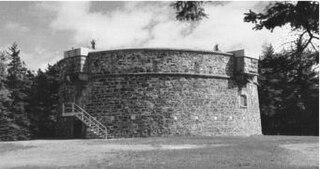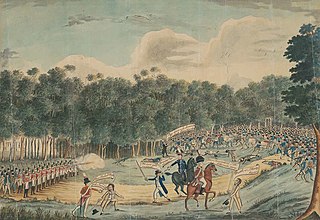| |||||
| Centuries: | |||||
|---|---|---|---|---|---|
| Decades: | |||||
| See also: | 1804 in the United Kingdom Other events of 1804 List of years in Ireland | ||||
Events from the year 1804 in Ireland.
| |||||
| Centuries: | |||||
|---|---|---|---|---|---|
| Decades: | |||||
| See also: | 1804 in the United Kingdom Other events of 1804 List of years in Ireland | ||||
Events from the year 1804 in Ireland.



Martello towers, sometimes known simply as Martellos, are small defensive forts that were built across the British Empire during the 19th century, from the time of the French Revolutionary Wars onwards. Most were coastal forts.

Sutton is a residential suburb on the Northside of Dublin, Ireland. It occupies the tombolo which links Howth Head to the mainland, some of the lower slopes of Howth Hill, and a little of the adjacent coasts. The area lies within the jurisdiction of Fingal County Council. There is a small commercial core at the Sutton Cross road intersection.

Howth is an affluent peninsular village and outer suburb of Dublin, Ireland. The district as a whole occupies the greater part of the peninsula of Howth Head, which forms the northern boundary of Dublin Bay, and includes the island of Ireland's Eye, which holds multiple natural protection designations.

The Castle Hill convict rebellion was an 1804 convict rebellion in the Castle Hill area of Sydney, against the colonial authorities of the British colony of New South Wales. The rebellion culminated in a battle fought between convicts and the colonial forces of Australia, on 5 March 1804 at Rouse Hill. It was dubbed Australia's Vinegar Hill after the previous Battle of Vinegar Hill, which had taken place during the Irish Rebellion of 1798. The incident was the first major convict uprising in Australian history to be suppressed under martial law.

Joseph Holt was a United Irish general and leader of a large guerrilla force which fought against British troops in County Wicklow from June–October 1798. He was exiled in 1799 to the colony of New South Wales where he worked as a farm manager for NSW Corp Paymaster Captain William Cox and later returned to Ireland in 1814.
The following lists events that happened during 1804 in Australia.
James Corcoran was an Irish rebel leader who following the suppression of the United Irish insurrection of 1798, maintained a guerrilla resistance to the British Crown forces in counties Wexford and Kilkenny until his final defeat and death in 1804.

Events from the year 1799 in Ireland.
Events from the year 1794 in Ireland.
Events from the year 1798 in Ireland.
General Sir Charles Menzies, was a senior Royal Marines officer. Although he became a respected soldier, fighting with Horatio Nelson in the Napoleonic Wars and later rising to the rank of general before becoming aide de camp to Queen Victoria, Menzies is best remembered for the founding of Newcastle, New South Wales and the successful commencement of its settlement between the age of 21 and 22.
Events from the year 1803 in Ireland.
Events from the 1400s in England.
Beauchamp Bagenal Harvey was a barrister and a commander of the United Irishmen in the Battle of New Ross during the 1798 Rebellion.
Events from the year 1583 in Ireland.

The Irish rebellion of 1803 was an attempt by Irish republicans to seize the seat of the British government in Ireland, Dublin Castle, and trigger a nationwide insurrection. Renewing the struggle of 1798, they were organised under a reconstituted United Irish directorate. Hopes of French aid, of a diversionary rising by radical militants in England, and of Presbyterians in the north-east rallying once more to the cause of a republic were disappointed. The rising in Dublin misfired, and after a series of street skirmishes, the rebels dispersed. Their principal leader, Robert Emmet, was executed; others went into exile.

Sutton Castle or Sutton House is a Victorian Tudor-style castellated mansion house with terraced gardens on the southern coast of Howth Head, overlooking Dublin Bay, in the suburbs of Dublin, Ireland.
29 Martello towers and battery installations were constructed or partially constructed in the Greater Dublin Area between 1803 and 1808. The towers were intended to act as a deterrent against a foreign invasion by Napoleon and his French Armies as well as being used as general lookout posts. In later years, towers were also used as coast guard stations, lookout stations to prevent smuggling and as other general purpose military installations by various British and Irish defence forces.
Redmond Roche was an Irish politician who sat for County Cork in the Parliament of 1640–1649. He was a Protestant during his earlier life but joined the Confederateses in 1642.
James Dixon (1758-1840) was an Irish Catholic priest who was transported to Australia and in 1803 became the first Catholic priest permitted to minister there.